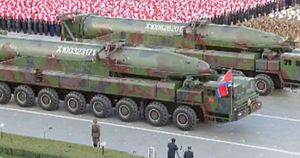Early Thursday morning, unnamed South Korean military officials told Yonhap News Agency that they had spotted two North Korean intercontinental ballistic missiles mounted on road-mobile launchers, suggesting that Pyongyang was readying itself for its first-ever ICBM test.
The North Korean Foreign Ministry had announced that the country could carry out an ICBM test “anytime and anywhere,” as “determined by the supreme headquarters of the DPRK” in a statement released by state media on January 8. The North Korean Foreign Ministry statement came after U.S. President-elect Donald J. Trump took to Twitter to comment on North Korean leader Kim Jong-un’s new year’s address, in which Kim said that Pyongyang had reached the final stages of ICBM development in 2016. Referring to the prospect of a North Korean ICBM, Trump said, “It won’t happen.”
That South Korean intelligence has spotted ICBMs on road-mobile launchers, thus, isn’t entirely unsurprising, even though it is a deeply concerning development after North Korea’s claimed thermonuclear warhead validation test in September 2016. What is surprising, however, is an additional detail included in the Yonhap report. Specifically, South Korean officials who spotted the ICBMs note that the missiles observed on the mobile launchers are neither the KN-08 nor the KN-14 ICBMs — the two known intercontinental-range missiles in North Korea’s inventory.
Instead, what we have from these sources is a missile that is estimated “to not exceed 15 meters in length,” but still described as an ICBM — making it something entirely new, possibly, or a longer-range variant of a medium-range Nodong missile, which would measure closer to the 15 meter length figure. (An extended-range Nodong would still likely fall far short of intercontinental ranges.) Both the untested KN-08 and KN-14 have been seen on video and North Korea watchers — and certainly South Korean intelligence — have a fairly good idea of their dimensions.
Reuters’ James Pearson also reported the story. A source who spoke to Chosun Ilbo is cited by Reuters as noting that the observed missile “was different from a conventional Musudan [or Hwasong-10] missile in its length and shape.” “It is possible they were moving it somewhere for assembly,” the source said, according to Reuters. Chosun Ilbo, citing anonymous South Korean military sources, notes that the missile could have been “the lower-half” of an ICBM. That raises more questions since, at 15 meters, the observed “half” would be far too large for a KN-08 and KN-14, which measure at 19-20 meters and 17-18 meters in length respectively.
The very active community of open source intelligence North Korea-watchers are meanwhile working to verify the claims that appear in these reports; if there is a new missile out there, the North Koreans will either show it off or it’ll be spotted in publicly available imagery soon. The possibility of a new ICBM prototype would largely be a surprise, especially given North Korea’s preference to unveil new pre-test missile tech with pomp and circumstance. As Melissa Hanham, a North Korea watcher at the James Martin Center for Nonproliferation Studies told me, “Typically, North Korea parades a new prototype.”
While plenty of questions remain about this possible third ICBM prototype in North Korea’s inventory, the prospect of a North Korean ICBM test looks increasingly real. For Donald Trump, who will be sworn into office as the 45th president of the United States on Friday, a North Korean ICBM test this spring is looking like a strong contender for a first foreign policy crisis. If my read on the signaling out of Pyongyang since Trump’s election win is accurate — based on the North Korea Foreign Ministry’s “long memo” and the lull in ballistic missile testing after an unusually busy first 10 months of 2016 — North Korea is feeling Trump out and giving the new administration time to offer an alternate course from the status quo pursued by Obama.
An inauguration day test — or a test during Trump’s first weekend in office — would corner the new administration into having to act tough, potentially giving North Korea more of the same U.S. policy. If Pyongyang’s play is to encourage a Trump rethink of U.S. North Korea policy, giving the new U.S. administration time will be part of the plan, with more subtle signals short of a test demonstrating credible progress toward a test in the offing. For instance, if this new missile prototype exists, we may see North Korean state media show it off. If Pyongyang does have a test scheduled, it may choose to sync up with the upcoming “auspicious” birthday anniversaries of Kim Jong-il (mid-February) and Kim Il-sung (mid-April). Last year, it launched the Kwangmyongsong-4 satellite and carried out its first-ever Hwasong-10 test (which failed) around those dates respectively. (Though this is far from a watertight prognostication heuristic; Kim Jong-un’s own birthday passed by a couple weeks ago without as much as a peep and he chose to carry out a nuclear test last year that same week.)
Regardless of where things stand with North Korea’s ICBM test readiness and what both Kim Jong-un and Donald Trump intend to do in the upcoming weeks, 2017 is shaping up to be the year of the North Korean ICBM after a 2016 that was defined by an unusually busy season of ballistic missile and nuclear testing.
Editor’s note: Here’s a helpful collection of evidence on where North Korea stands with its ICBM development, courtesy of Melissa Hanham at the ArmsControlWonk blog.

































